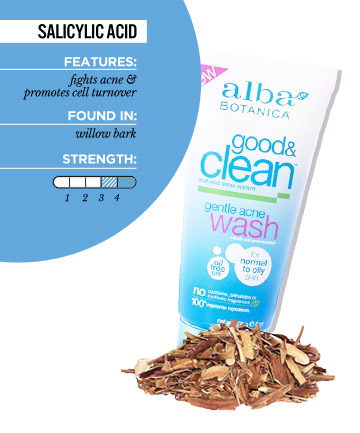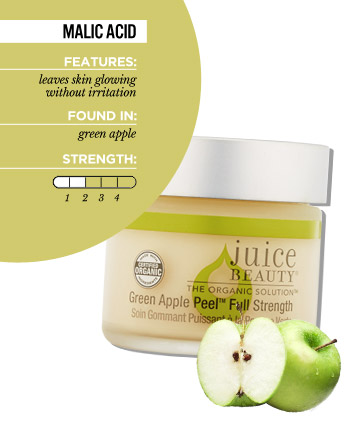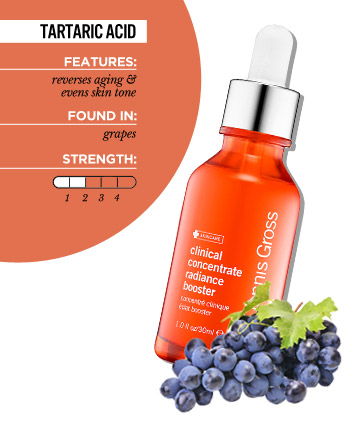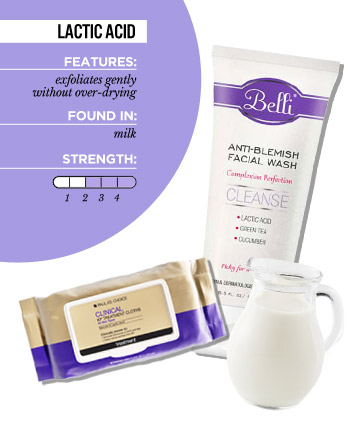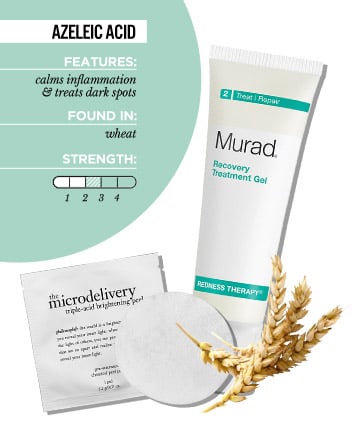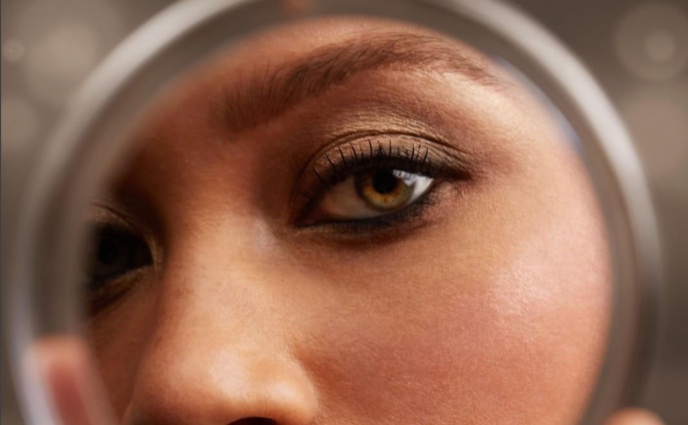Salicylic acid
Comes from: willow bark
Strength: 3/5 or 4/5, depending on concentration
Why: Salicylic acid is the gold standard in acne-clearing acids and the active ingredient in acne treatments from drugstore aisles to department store counters. Not only does it dry out pimples, it encourages cell turnover to more quickly fade post-acne marks and generally brighten skin.
Most alpha hydroxy acids do their work on the skin's surface, loosening the glue that holds skin cells together so dead cells are more easily swept away. As a beta hydroxy acid, salicylic acid "penetrates the pores while exfoliating," says Tanzi, so it actually helps break up the sebum plugs that cause a pimple. If you have acne, says Tanzi, "look for two percent salicylic acid for the highest concentration in an over-the-counter product." You can also find it in higher concentrations in professional-grade chemical peels.
Buy: Alba Botanica Good & Clean Gentle Acne Wash, $9
Comes from: willow bark
Strength: 3/5 or 4/5, depending on concentration
Why: Salicylic acid is the gold standard in acne-clearing acids and the active ingredient in acne treatments from drugstore aisles to department store counters. Not only does it dry out pimples, it encourages cell turnover to more quickly fade post-acne marks and generally brighten skin.
Most alpha hydroxy acids do their work on the skin's surface, loosening the glue that holds skin cells together so dead cells are more easily swept away. As a beta hydroxy acid, salicylic acid "penetrates the pores while exfoliating," says Tanzi, so it actually helps break up the sebum plugs that cause a pimple. If you have acne, says Tanzi, "look for two percent salicylic acid for the highest concentration in an over-the-counter product." You can also find it in higher concentrations in professional-grade chemical peels.
Buy: Alba Botanica Good & Clean Gentle Acne Wash, $9
Malic acid
Comes from: sour fruits like green apple and rhubarb
Strength: 2/5
Why: So you want to get a glow, but you don't want to melt your face off? Noted. Check out products with malic acid, the alpha hydroxy acid that gives a green apple its characteristic mouth-puckering taste. "It's not as stable as glycolic acid," says Tanzi, but this weaker ingredient is ideal for "people with sensitive skin." If your delicate skin makes you afraid of AHAs, start small with a malic acid product and use it a few times a week before building up to everyday use. Mandelic acid, derived from the bitter almond, and citric acids are other mild alpha hydroxy acids that work well with easily irritated skin.
Buy: Juice Beauty Green Apple Peel Sensitive, $39
Comes from: sour fruits like green apple and rhubarb
Strength: 2/5
Why: So you want to get a glow, but you don't want to melt your face off? Noted. Check out products with malic acid, the alpha hydroxy acid that gives a green apple its characteristic mouth-puckering taste. "It's not as stable as glycolic acid," says Tanzi, but this weaker ingredient is ideal for "people with sensitive skin." If your delicate skin makes you afraid of AHAs, start small with a malic acid product and use it a few times a week before building up to everyday use. Mandelic acid, derived from the bitter almond, and citric acids are other mild alpha hydroxy acids that work well with easily irritated skin.
Buy: Juice Beauty Green Apple Peel Sensitive, $39
Tartaric acid
Comes from: grapes
Strength: 2/5
Why: In case it's not obvious by now, if you have mature skin, you need to use an alpha or beta hydroxy acid product. "Acids help with surface skin-cell turnover, which slows dramatically with age," Tanzi explains. "When used regularly (followed by a good, hydrating moisturizer), they can help reduce age spots, brighten the skin and leave it more even-toned with a radiant glow." In other words, AHAs trick your skin into behaving like it's younger.
Aging, sensitive skin types can benefit from tartaric acid, a mild exfoliator and antioxidant in one. Most botanically derived skin acids have at least some antioxidant properties, but grape-derived tartaric acid is particularly potent. So not only does tartaric acid help reverse the signs of aging in mature skin, thanks to light exfoliation and antioxidant vitamins, it also helps prevent future damage.
Buy: Dr. Dennis Gross Skincare Clinical Concentrate Radiance Booster, $68
Comes from: grapes
Strength: 2/5
Why: In case it's not obvious by now, if you have mature skin, you need to use an alpha or beta hydroxy acid product. "Acids help with surface skin-cell turnover, which slows dramatically with age," Tanzi explains. "When used regularly (followed by a good, hydrating moisturizer), they can help reduce age spots, brighten the skin and leave it more even-toned with a radiant glow." In other words, AHAs trick your skin into behaving like it's younger.
Aging, sensitive skin types can benefit from tartaric acid, a mild exfoliator and antioxidant in one. Most botanically derived skin acids have at least some antioxidant properties, but grape-derived tartaric acid is particularly potent. So not only does tartaric acid help reverse the signs of aging in mature skin, thanks to light exfoliation and antioxidant vitamins, it also helps prevent future damage.
Buy: Dr. Dennis Gross Skincare Clinical Concentrate Radiance Booster, $68
Lactic acid
Comes from: milk
Strength: 2/5
Why: It's hard to miss lactic acid when it's in your skin-care products. (The faint sour-milk smell? Unavoidable.) But the dairy-derived acid has its perks. It's similar to glycolic acid but is made up of larger molecules that don't penetrate the skin as deeply, making it better tolerated by irritation-prone skin.
If you have keratosis pilaris (aka chicken skin), you've probably seen it in KP treatments — it breaks down the keratin that causes those annoying bumps to form without over-drying skin.
Pregnant women are told to avoid using products with salicylic acid, so if you're preggers and blemish-prone, lactic acid products can help by gently exfoliating the dead skin cells that contribute to pimple formation.
Buy: Paula's Choice Clinical KP Treatment Cloths, $32; Belli Skin Care Anti-Blemish Facial Wash, $22
Comes from: milk
Strength: 2/5
Why: It's hard to miss lactic acid when it's in your skin-care products. (The faint sour-milk smell? Unavoidable.) But the dairy-derived acid has its perks. It's similar to glycolic acid but is made up of larger molecules that don't penetrate the skin as deeply, making it better tolerated by irritation-prone skin.
If you have keratosis pilaris (aka chicken skin), you've probably seen it in KP treatments — it breaks down the keratin that causes those annoying bumps to form without over-drying skin.
Pregnant women are told to avoid using products with salicylic acid, so if you're preggers and blemish-prone, lactic acid products can help by gently exfoliating the dead skin cells that contribute to pimple formation.
Buy: Paula's Choice Clinical KP Treatment Cloths, $32; Belli Skin Care Anti-Blemish Facial Wash, $22
Azeleic acid
Found in: grains like wheat and barley
Strength: 2/5 or 3/5, depending on concentration
Why: Soothing, antibacterial azeleic acid is the perfect match for rosacea sufferers. Azeleic acid is ideal for calming the inflammation that triggers redness and pimple-like bumps, two of rosacea's biggest bummers.
You might also find azeleic acid in products for treating dark spots, which is caused and exacerbated by inflammation. "[It] has lightening properties and anti-inflammatory properties," Tanzi points out, "so [it's] good for people with discoloration or melasma," she says.
Buy: Murad Redness Therapy Recovery Treatment Gel, $54; Philosophy the Microdelivery Triple-Acid Brightening Peel, $70
Found in: grains like wheat and barley
Strength: 2/5 or 3/5, depending on concentration
Why: Soothing, antibacterial azeleic acid is the perfect match for rosacea sufferers. Azeleic acid is ideal for calming the inflammation that triggers redness and pimple-like bumps, two of rosacea's biggest bummers.
You might also find azeleic acid in products for treating dark spots, which is caused and exacerbated by inflammation. "[It] has lightening properties and anti-inflammatory properties," Tanzi points out, "so [it's] good for people with discoloration or melasma," she says.
Buy: Murad Redness Therapy Recovery Treatment Gel, $54; Philosophy the Microdelivery Triple-Acid Brightening Peel, $70
Alpha hydroxy acids and beta hydroxy acids are the workhorses of your skin care routine. They exfoliate dull skin and fade imperfections, minus scratchy microbeads. Pretty much everyone can benefit from having acid in her routines -- but you shouldn't pick just any ol' AHA cleanser. If you wanna get nerdy about it, the various alpha hydroxy acids and beta hydroxy acids (like salicylic acid, glycolic acid, lactic acid and malic acid) work differently on a molecular level, and choosing which one to use can make or break your skin. We asked Dr. Elizabeth Tanzi, M.D., a Washington, D.C.-based dermatologist, to decode some of the most common AHAs and BHAs and tell which one you should be using.


